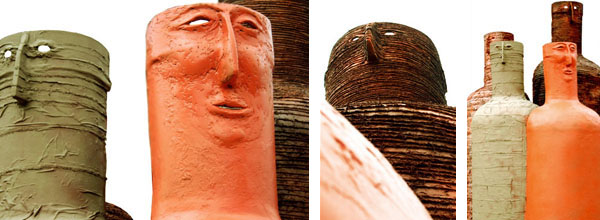Sometimes there’s a moment when my brand design work allows me to express something more than an image strategy. That is a while where I am so emotionally mobilized, that the job encourages me to explore new materials and alternative resources to communicate things.
That happened to me in a work I did for a winery. In this task, I proposed the construction of a symbol. An easily identified and located symbol, one that people of the city would talk about. So I suggested building a sculpture, in signal with the new corporate visual identity scheme had designed.
For my part, I needed to express myself by something material. Symbol’s design has its magic, but working with tangible objects gives me a unique energy. At that stage, I had just finished my dissertation and was the ideal time for me to build something corporeal, to fight with materials rather than with ideas.
Technically, I wanted to work with fibreglass. I never did it before and I was intrigued about what I could get out of it.
Work’s started: first I made a cardboard mock-up of about 35 cm. of the future sculpture of 3,5 meters high, which was approved by the client. Then I contacted a specialist on building and repairing of boats with fibre.
From him, I learned the logic of the material. In addition it was he who copied each bottle and that helped us throughout the process.
From his advice, we built along with my assistant Lucia Spain (photo) a wooden skeleton, lined with a fine plaque of wood and wire mesh in the curved parts. We cover the joints with fillings and then painted everything with several coats of enamel. That was the mother, who worked as a template. From that mould, 4 bottles were copied.
The four bottles were the same, they had no particular features. That allowed me to further humanize each of them, looking for enrich the whole group. In this way, each bottle was cut to a different height so that the visual rhythm of the group was the one that interested me. Then I worked the factions with mastic, trying to maintain certain coarseness in the final aspect, in order to disguise the coolness and the perfection of the fiberglass.
As soon as each bottle was ready, we started to apply to each bottle a different texture: the first was plain, the second with torn fabric, the third with strips of burlap and the fourth with rustic wire.
Having fixed these materials, we impregnated them with liquid resin to make impervious to the elements, and therefore to make the sculpture endure without complications for at least more than five years (as happened). Then the bottles were united and the whole set was bolted to a concrete block, that was built on the site. To avoid the impact of the wind, part of the interior of the structure was filled out with stones and sand, which allowed not suffer falls or cracks.
Finally the sculpture was painted with several coats of enamel. Spray was applied in some places to emphasize the uniqueness of each texture.
In parallel with the sculpture, we constructed a series of shelves for certain wines. These structures look like wooden barrels, which were humanized by cropping its silhouettes. The construction of the shelves was done by Esther Lamas.
As a balance, these artefacts, together with the local colour selection and the design of the traditional graphical elements, achieved the integration of each message of the winery into a coherent whole. On the other hand, this work allowed me to express myself freely. Something that at that time was important for me.
Sebastian Guerrini




